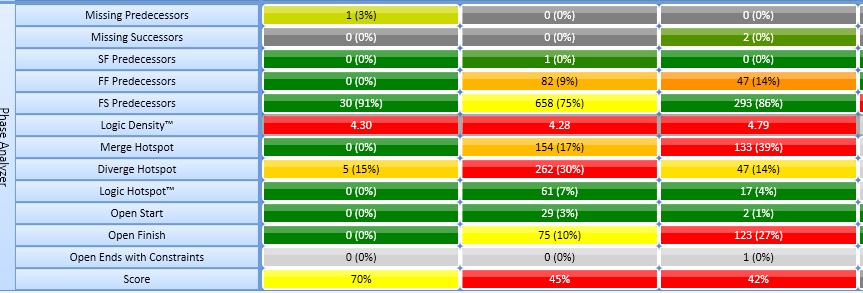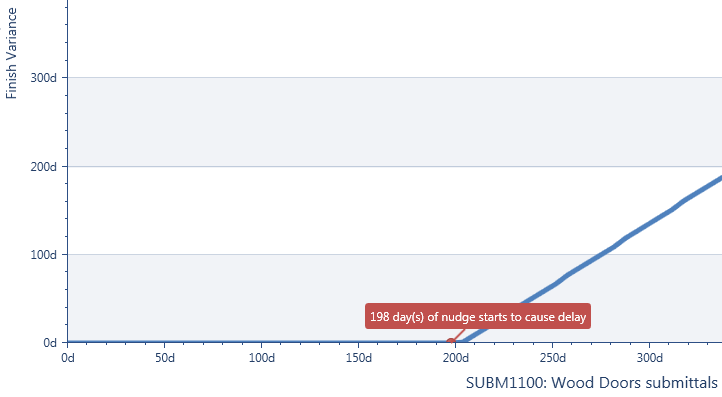Acumen Fuse Logic: Tracing Your Way Back to the Origin of the Network
The more erroneous and superfluous relationships you establish in your schedule, the more you lose sight of the organic critical path, and with that, control over the back-end, or closing out of your projects. Acumen Fuse Logic weeds out extranneous data before it can deprecate your network. Many schedules have errors built-in from the baseline. Along the way, perhaps 25%, the logic begins to deprecate, with pages of out-of-sequence activities needing tweaking. All activities are now critical, and there are no longer discernible paths.
The Acumen Fuse Logic tab is where Fuse lets you drill down into, and filter and sort every activity relationship, as well as lags and leads, and dangling activities, while you conduct Logic Checks, and Logic Analyses, to identify and correct mistakes. As you see your score, you’re reminding yourself not to goose Logic Density™ by loading up redundant activity relationships.
The Acumen Fuse Logic tab
-where you can drill down into the nitty-gritty of relationships.
Relationship Types
It is in this window that you can have at your fingertips every relationship on the project, as well as Logic Hotspots, or pinch-points, where a large group of activities merge-diverge. The Logic metric, in Diagnostics, takes data from the Logic tab, and gives you the stats:
Overall Score: 35% (avg.)
The open ended activities at the top are a no-brainer. However; in this case, Fuse notes 44-56% start-to-start saturation, whereas <10% is set as level green. Logic Density™, >4, is rated high, as well. As I said in my previous post, the nature of aggressive schedules induces start-to-start saturation.
Lags & Leads
If you have too many SS + lag relationships, you can modify them by adding an activity to represent the lag, as Cleanser does, or the activity could be split. Thus:
becomes
The lag is removed, but start-to-start remains. Frankly, I don’t see a work-around start-to-start overuse, so if I desire, I can simply drag the SS Predecessor metric out of the analyzer. Naturally, my over all score will shoot up:
Overall score 52%
Logic Checks
The Logic Checks menu offers reports on the more obvious mistakes, such as circular and reverse logic, out-of-sequence, open-ends, summary ties, et al., but more interesting and useful is the Redundancy Index™, which identifies all redundant relationships, as I discussed last week. Remember that it isn’t necessary to delineate associative activity relationships:
A redundant link would be the A/C relationship, below
These are just some of the relationships you can wipe away in one click, using Cleanse, as I demonstrated last week.
Dangling Activities
Relatives of start-to-start activities are Dangling Activities, or when you string together a path of activities FF … SS, a practice for which Fuse will de-rate your Logic score, based on acceptable degrees of saturation. The thinking is that
“Dangling activities occur as a result of a FF or SF predecessor link (open start) or SS or SF successor link (open finish) and not when there are any missing predecessors or successors. The successor ends up with an open start and the predecessor ends up with an open finish.”
Logic Analysis
Logic Analysis includes the tools Logic Sensitivity™ and Logic Trace.
Logic Sensitivity charts the trajectory of a potential delay, on a given activity, over the critical path of the project, according to your project logic
The above query, Published to the Clipboard represented in the following graph
As well as an Excel spreadsheet from which the data-set is gleaned..
This is pretty handy when you want to quickly model different delay scenarios in real time. For example, if a potential delay topic arises in a progress meeting, you could model the impact of any activity in the delay path with a few key strokes. Compare the difficulty of trying to do the same thing manually in a scheduling program.
(*Logic Trace was not operable in the trial version)
Publish
As with all other tools, any metric reports or graphs, are readily output into multi-worksheet tallies, that give your reports operability that you can share, if you desire. If you’re in the business of delay claims, you’ll soon realize just how valuable it is to have this information disseminated in such a way that it will in itself provide compelling evidence to your narrative. For Daubert purposes, it behooves one to become acquainted with the DCMA, GAO, et al., standards that many of Fuse’s metrics are based on, and are generally accepted in the court systems.


















